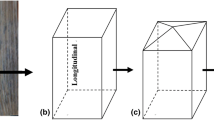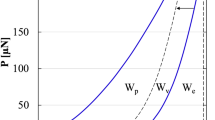Abstract
Nanoindentation is a powerful tool for hardness testing on a very small scale. Since the technique was first introduced for studying wood cell wall mechanics, it has been integrated as an important tool for measuring the modulus of elasticity and hardness of wood cell walls. In this study, hardness measured with nanoindentation (nanohardness) was compared with hardness measured by the standard Brinell test method (Brinell hardness) on jack pine (Pinus banksiana Lamb.) wood. Nanoindentation was performed on both the S2 layer of the secondary cell wall and the middle lamella (ML) of early- and latewood fibers. Four annual growth rings were studied. The influence of growth ring and initial spacing on both measurements was analyzed. The relationship between Brinell hardness, nanoindentation measurements, and average ring density was also studied. Results suggest that Brinell- and nanohardness are controlled by different mechanisms and factors. The location of nanohardness measurements (i.e., S2 layer or ML) also influenced hardness differently. It was concluded that nanomeasurements are not an exact representation of wood mechanical properties conducted at the macro level because of the hierarchical structure of wood. The effect of other factors such as moisture or wood extractive content may also need consideration.







Similar content being viewed by others
References
Alteyrac J, Zhang SY, Cloutier A, Ruel JC (2005) Influence of stand density on ring width and wood density at different sampling heights in black spruce (Picea mariana (Mill.) BSP). Wood Fiber Sci 37(1):83–94
Auty D (2011) Modelling the effects of forest management on the wood properties and branch characteristics of UK-grown Scots pine. PhD thesis, University of Aberdeen
Auty D, Gardiner BA, Achim A, Moore JR, Cameron AD (2013) Models for predicting microfibril angle variation in Scots pine. Ann For Sci 70(2):209–218. doi:10.1007/s13595-012-0248-6
Bendtsen BA (1978) Properties of wood from improved and intensively managed trees. For Prod J 28(10):61–72
Bergander A, Brandstrom J, Daniel G, Salmen L (2002) Fibril angle variability in earlywood of Norway spruce using soft rot cavities and polarization confocal microscopy. J Wood Sci 48(4):255–263
Campbell A, Kim W-J, Koch P (1990) Chemical variation in lodgepole pine with sapwood/heartwood, stem height, and variety. Wood Fiber Sci 22(1):22–30
Debell DS, Singleton R, Gartner BL, Marshall DD (2004) Wood density of young-growth western hemlock: relation to ring age, radial growth, stand density, and site quality. Can J For Res 34(12):2433–2442
Donaldson L (2008) Microfibril angle: measurement, variation and relationships: a review. IAWA J 29(4):345–386
Duchesne I, Tong T, Torquatos LP, Escobar WG, Bustos C, Achim A, Concha K, Cloutier A (2011) Impact of spacing on modulus of elasticity and hardness of jack pine cell walls. Paper presented at the 2011 Annual Meeting of the International Academy of Wood Science, Stockholm, Sweden
Durbin J, Watson GS (1951) Testing for serial correlation in least squares regression II. Biometrika 38(1/2):159–177
Fischer-Cripps AC (2000) A review of analysis methods for sub-micron indentation testing. Vacuum 58(4):569–585
Frihart CR, Yelle DJ, Ralph J, Moon RJ, Stone DS, Jakes JE (2008) Enhanced understanding of the relationship between chemical modification and mechanical properties of wood “Innovation and Challenges in Biobased Composites: How Far to the New Frontier?” In: Csiro, Scion (eds) 9th Pacific rim biobased composites symposium. Rotorua, New Zealand, pp 141–147
Gindl W, Gupta HS (2002) Cell-wall hardness and Young’s modulus of melamine-modified spruce wood by nano-indentation. Compos A Appl Sci Manuf 33(8):1141–1145
Gindl W, Schöberl T (2004) The significance of the elastic modulus of wood cell walls obtained from nanoindentation measurements. Compos A Appl Sci Manuf 35(11):1345–1349
Gindl W, Gupta HS, Grünwald C (2002) Lignification of spruce tracheid secondary cell walls related to longitudinal hardness and modulus of elasticity using nano-indentation. Can J Bot 80(10):1029–1033
Gindl W, Gupta HS, Schöberl T, Lichtenegger HC, Fratzl P (2004) Mechanical properties of spruce wood cell walls by nanoindentation. Appl Phys A Mater Sci Process 79(8):2069–2073
Gominho J, Pereira H (2000) Variability of heartwood content in plantation-grown Eucalyptus globulus Labill. Wood Fiber Sci 32(2):189–195
Green DW, Begel M, Nelson W (2006) Janka hardness using nonstandard specimens. Research Note FPL-RN-0303. US Department of Agriculture, Forest Service, Forest Products Laboratory. Madison, WI, Madison, WI
He LH, Swain MV (2011) 3.306—Microindentation. In: Ducheyne P (ed) Comprehensive biomaterials. Elsevier, Oxford, pp 75–90. ISBN 978-0-08-055294-1
Holmberg H (2000) Influence of grain angle on Brinell hardness of Scots pine (Pinus sylvestris L.). Holz Roh- Werkst 58(1–2):91–95
Huang YH, Fei BH, Yu Y, Wang SQ, Shi ZQ, Zhao RJ (2012) Modulus of elasticity and hardness of compression and opposite wood cell walls of masson pine. Bioresources 7(3):3028–3037
Jäger A, Bader T, Hofstetter K, Eberhardsteiner J (2011) The relation between indentation modulus, microfibril angle, and elastic properties of wood cell walls. Compos A Appl Sci Manuf 42:677–685
Jakes JE, Frihart CR, Beecher JF, Moon RJ, Stone DS (2008a) Experimental method to account for structural compliance in nanoindentation measurements. J Mater Res 23(4):1113–1127
Jakes JE, Stone DS, Frihart CR (2008b) Nanoindentation methods for wood: adhesive bond lines. Paper presented at the proceedings 31st annual Meeting of the Adhesion Society, Inc., Austin, TX, 2008 February 17–20
Jakes JE, Frihart CR, Beecher JF, Moon RJ, Resto PJ, Melgarejo ZH, Suarez OM, Baumgart H, Elmustafa AA, Stone DS (2009) Nanoindentation near the edge. J Mater Res 24(3):1016–1031
Jozsa LA, Middleton GR (1997) Les caractéristiques déterminant la qualité du bois: nature et conséquences pratiques. Publication spéciale SP-34F, Forintek Canada Corp. edn. Forintek Canada Corp., Sainte-Foy
Jungnikl K, Koch G, Burgert I (2008) A comprehensive analysis of the relation of cellulose microfibril orientation and lignin content in the S2 layer of different tissue types of spruce wood (Picea abies (L.) Karst). Holzforschung 62(4):475–480
Kang KY, Zhang SY, Mansfield SD (2004) The effects of initial spacing on wood density, fibre and pulp properties in jack pine (Pinus banksiana Lamb.). Holzforschung 58(5):455–463
Keith CT, Chauret G (1988) Basic wood properties of European larch from fast-growth plantations in eastern Canada. Can J For Res 18(10):1325–1331
Koga S, Zhang SY (2002) Relationships between wood density and annual growth rate components in balsam fir (Abies balsamea). Wood Fiber Sci 34(1):146–157
Konnerth J, Gindl W (2006) Mechanical characterisation of wood-adhesive interphase cell walls by nanoindentation. Holzforschung 60(4):429–433
Konnerth J, Gierlinger N, Keckes J, Gindl W (2009) Actual versus apparent within cell wall variability of nanoindentation results from wood cell walls related to cellulose microfibril angle. J Mater Sci 44(16):4399–4406
Konnerth J, Eiser M, Jager A, Bader TK, Hofstetter K, Follrich J, Ters T, Hansmann C, Wimmer R (2010) Macro- and micro-mechanical properties of red oak wood (Quercus rubra L.) treated with hemicellulases. Holzforschung 64(4):447–453
Lasserre JP, Mason EG, Watt MS, Moore JR (2009) Influence of initial planting spacing and genotype on microfibril angle, wood density, fibre properties and modulus of elasticity in Pinus radiata D. Don corewood. For Ecol Manag 258(9):1924–1931
Lindström H, Evans JW, Verrill SP (1998) Influence of cambial age and growth conditions on microfibril angle in young Norway spruce (Picea abies [L.] Karst.). Holzforschung 52(6):573–581
Mäkinen H, Hynynen J, Isomäki A (2005) Intensive management of Scots pine stands in southern Finland: First empirical results and simulated further development. For Ecol Manag 215:37–50
Meng Y (2010) Methods for characterizing mechanical properties of wood cell walls via nanoindentation. University of Tennessee, Knoxville
Moon RJ, Frihart CR, Wegner T (2006) Nanotechnology applications in the forest products industry. Forest Prod J 55(5):4–10
Moon RJ, Jakes JE, Beecher JF, Frihart CR, Stone DS (2009) Relating nanoindentation to macroindentation of wood. In: Hse C-Y, Jiang Z, Kuo M-L (eds) Advanced biomass science and technology for bio-based products, Beijing, China, 2009. Chinese Academy of Forestry & USDA Forest Service, Southern Research Station, pp 145–159
Morling T, Valinger E (1999) Effects of fertilization and thinning on heartwood area, sapwood area and growth in Scots pine. Scand J For Res 14(5):462–469
Nelder JA (1962) New kinds of systematic designs for spacing experiments. Biometrics 18(3):283–307
Oliver WC, Pharr GM (1992) An improved technique for determining hardness and elastic modulus using load and displacement sensing indentation experiments. J Mater Res 7(6):1564–1583
Savva Y, Koubaa A, Tremblay F, Bergeron Y (2010) Effects of radial growth, tree age, climate, and seed origin on wood density of diverse jack pine populations. Trees Struct Funct 24(1):53–65
Schneider R, Zhang SY, Swift DE, Begin J, Lussier JM (2008) Predicting selected wood properties of jack pine following commercial thinning. Can J For Res 38(7):2030–2043
Sellin A (1994) Sapwood-heartwood proportion related to tree diameter, age, and growth rate in Picea abies. Can J For Res 24(5):1022–1028
Shmulsky R, Jones PD (2011) Density and specific gravity. In: Wiley-Blackwell (ed) Forest products and wood science: an introduction, 6th edn. Wiley, New York, pp 175–195
Spurr AR (1969) A low-viscosity epoxy resin embedding medium for electron microscopy. J Ultrastruct Res 26:31–43
Taylor A, Gartner B, Morrell J (2002) Heartwood formation and natural durability: a review. Wood Fiber Sci 34(4):587–611
Tong QJ, Duchesne I, Belley D, Beaudoin M, Swift E (2013) Characterization of knots in plantation white spruce. Wood Fiber Sci 45(1):1–14
Tze WTY, Wang S, Rials TG, Pharr GM, Kelley SS (2007) Nanoindentation of wood cell walls: continuous stiffness and hardness measurements. Compos A Appl Sci Manuf 38(3):945–953
Weinan E, Engquist B (2003) Multiscale modeling and computation. Notice AMS 50(9):1062–1070
Wimmer R, Lucas NB (1997) Comparing mechanical properties of secondary wall and cell corner middle lamella in spruce wood. IAWA J 18(1):77–88
Yan M (2001) Prospect nanometer and micrometer science and technology for applying to the wood industry. Sci Silvae Sin 37(6):9–12
Yang KC, Hazenberg G (1992) Impact of Spacings on Sapwood and Heartwood Thickness in Picea mariana (Mill) BSP and Picea glauca (Moench) VOSS. Wood Fiber Sci 24(3):330–336
Zobel BJ, Sprague JR (1998) Juvenile wood in forest trees. Springer series in wood science. Springer, Berlin
Acknowledgments
This study was supported by ForValueNet and NSERC (the Natural Sciences and Engineering Research Council of Canada) Strategic Network. We would like to thank Michel Beaudoin, Université Laval, and Michèle Bernier-Cardou, Canadian Forest Service, for their constructive and critical comments that helped to improve the manuscript; Luciane Paes Torquato at Université Laval, and Katherine Concha and Paulina Valenzula at the Universidad del Bío-Bío for their nanoindentation work. We also thank Alain Cloutier and Alexis Achim at Université Laval for providing the opportunity for this study. Finally, special thanks are due to Denis Belley at Université Laval and Edwin Swift and his team at the Canadian Wood Fibre Centre in New Brunswick for the fieldwork.
Author information
Authors and Affiliations
Corresponding author
Rights and permissions
About this article
Cite this article
Vincent, M., Tong, Q., Terziev, N. et al. A comparison of nanoindentation cell wall hardness and Brinell wood hardness in jack pine (Pinus banksiana Lamb.). Wood Sci Technol 48, 7–22 (2014). https://doi.org/10.1007/s00226-013-0580-5
Received:
Published:
Issue Date:
DOI: https://doi.org/10.1007/s00226-013-0580-5




